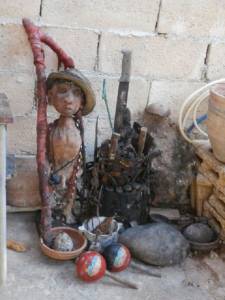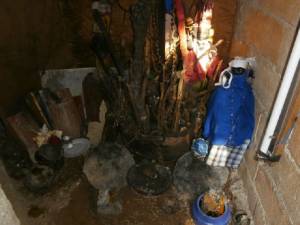My First Encounters with Santería
Ariel Glaria Enríquez

HAVANA TIMES — Like childhood’s many other discoveries, which occur simultaneously, I was invited for my first time to a Yoruba* ritual drumming party when I was 9 years old and found myself alone in front of a santera.
One morning, Hurraca invited all the kids from the block to a drumming party which his godmother Carmelina, the most famous santera in our neighbourhood, offered in name of the Orishas* saints, the day after.
The “party” was planned to take place at 6 p.m. When a lot of us were still sleeping, two police cars pulled up and parked outside Carmelina’s door. Nearing noon, a large crowd of strangers waited on corners and in doorways along my street. Hurraca, shining under the scorching midday sun, didn’t stop running from group to group to take messages before taking them back to his godmother’s ears.
Between 2 p.m. and 3 p.m., dressed like Yoruba royalty, having just lit a new cigar and calm, Carmelina called to the boss of the police cars. Getting out of the car, a police officer with straight hair shut the car door with a slam, he returned quickly, relaxed and smiling, this time he treated the car door with great care and with one wave of his arm ordered the other police car to follow behind him.
Only a miracle kept the glass and walls of Carmelina’s house in tact once the ancestral rhythm of drums began to sound. Later, covered in sweat, Hurraca emerged from the large crowd of people who were filling the house. A knowing smile brightened up his face, when he appeared on the street in front of us with two trays of sweets. Amongst food, drinks, chorus’, drums and dance, when people still pretended to believe, the Orishas had their party.
Another day, during the holidays that same year, standing in Carmelina’s doorway, the sun projected my shadow leaning on the doorframe onto a rectangular shape of sunlight which lit up her living room floor. This sunlight cast a clear half-shadow on everything else and every object appeared to radiate its own light.
The house appeared to be empty. At the back of the house, at the end of the dining room, dressed in red and black stood Changó*. Next to his altar, a small pile of glass balls filled a clay pot. Without thinking, I walked across the living room. I had already taken the balls when I discovered a space I never knew existed, where Carmelina slept in an armchair. My knees began to shake uncontrollably. I squeezed my hands holding the balls towards my stomach and looked around for the door.

Once I got to the street, my neighbour had woken up. “Returnto Eleggua* what is missing from him”, she said calmly, looking at me from above the rims of her glasses. I went back to the dining room. Bending down, I discovered a monolith with eyes and a mouth made of seashells in the middle of the pot; behind it, stood a guava stick cane with a red piece of cloth tied around one end; nearby, there was the faint reflection of a metal pot full of unknown objects. The strong smell of wild leaves, which to this day I can still remember vividly, came from that corner. “Take the white balls only”, I heard her say.
Walking past her once again, I felt her soft and large hand on my shoulder.”You are Obbatalá’s* son” she said, and something else about my fate. In the street, the midday sun struck me in the face. Turning around, I saw the illuminated rectangle of sunlight again where hundreds of particles moved about before being lost in the shadows and in my hands – I counted them over and over again – there were nine white balls.
In 1998, just before my 29th birthday, I found out that Carmelina hid all of the altars and saints I remembered so clearly from my childhood in her bedroom.
The news didn’t surprise my mother, who without taking her eyes off the stove told me what she had heard from a neighbour of ours one afternoon at the bodega store on the corner. “In Cuba, santería has become a business and a joke”, she said.
In April 2001, defeated by diabetes, Carmelina left this world. During her burial, an old pipe broke out of a bathroom wall in her house. The dining room and living room were flooded. The clean water flowed from under her door looking for the slope of the street.
Up until this day, Hurraca, old now with few teeth, assures us that the Saints cried for three days after his godmother’s death.
—–
Yoruba: African ethnic group.
Orishas: Yoruba deities or saints.
Eleggua: Child Orisha. He opens the roads of life.
Changó: Old Orisha. King of the Orishas.
Obbatalá: Orisha of wisdom and intelligence. The color white represents him.





